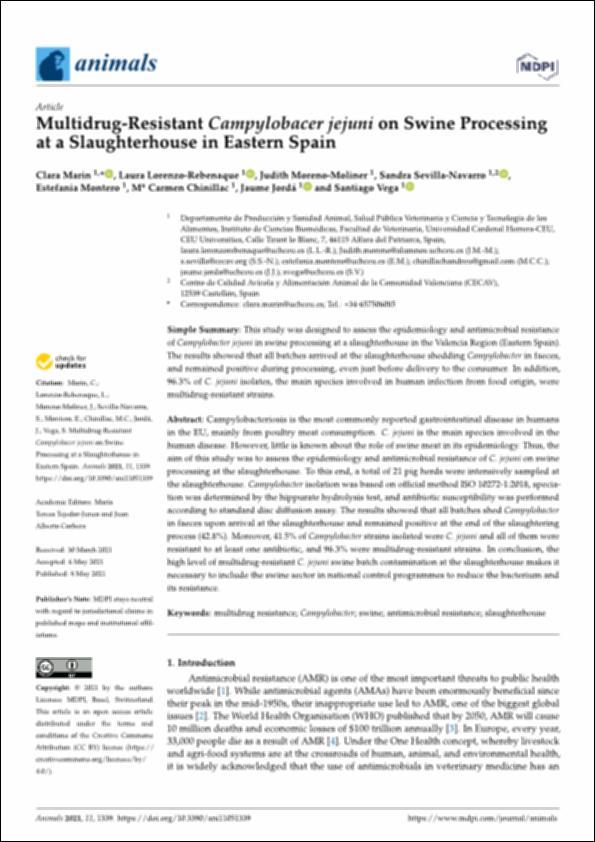Por favor, use este identificador para citar o enlazar este ítem:
http://hdl.handle.net/10637/13449Multidrug-resistant "Campylobacer jejuni" on swine processing at a slaughterhouse in Eastern Spain
| Título : | Multidrug-resistant "Campylobacer jejuni" on swine processing at a slaughterhouse in Eastern Spain |
| Autor : | Lorenzo Rebenaque, Laura Moreno Moliner, Judith Sevilla Navarro, Sandra Montero Cortijo, Estefanía Chinillach Andreu, María Carmen Jordá Moret, Jaume Vicent Vega García, Santiago Marín Orenga, Clara |
| Materias: | Vibriosis - Spain - Valencia (Autonomous Community); Cerdos - Enfermedades infecciosas - España - Comunidad Valenciana.; Vibriosis - España - Comunidad Valenciana.; Drug resistance in microorganisms.; Mataderos - Control de calidad.; Slaughtering and slaughter-houses - Quality control.; Swine - Communicable diseases - Spain - Valencia (Autonomous Community); Bacterias - Resistencia a los medicamentos. |
| Editorial : | MDPI |
| Citación : | Marin, C., Lorenzo-Rebenaque, L., Moreno-Moliner, J., Sevilla-Navarro, S., Montero, E., Chinillac, M. C., Jordá, J. & Vega, S. (2021). Multidrug-resistant "Campylobacer jejuni" on swine processing at a slaughterhouse in Eastern Spain. Animals, vol. 11, i. 5 (08 may.), art. 1339. DOI: https://doi.org/10.3390/ani11051339 |
| Resumen : | Campylobacteriosis is the most commonly reported gastrointestinal disease in humans in the EU, mainly from poultry meat consumption. C. jejuni is the main species involved in the human disease. However, little is known about the role of swine meat in its epidemiology. Thus, the aim of this study was to assess the epidemiology and antimicrobial resistance of C. jejuni on swine processing at the slaughterhouse. To this end, a total of 21 pig herds were intensively sampled at the slaughterhouse. Campylobacter isolation was based on official method ISO 10272-1:2018, speciation was determined by the hippurate hydrolysis test, and antibiotic susceptibility was performed according to standard disc diffusion assay. The results showed that all batches shed Campylobacter in faeces upon arrival at the slaughterhouse and remained positive at the end of the slaughtering process (42.8%). Moreover, 41.5% of Campylobacter strains isolated were C. jejuni and all of them were resistant to at least one antibiotic, and 96.3% were multidrug-resistant strains. In conclusion, the high level of multidrug-resistant C. jejuni swine batch contamination at the slaughterhouse makes it necessary to include the swine sector in national control programmes to reduce the bacterium and its resistance. |
| Descripción : | Este artículo se encuentra disponible en la siguiente URL: https://www.mdpi.com/2076-2615/11/5/1339 Este artículo pertenece al número especial "Animal Infectious Diseases Caused by Multidrug-Resistant Bacteria: A One-Health Issue". |
| URI : | http://hdl.handle.net/10637/13449 |
| Derechos: | http://creativecommons.org/licenses/by/4.0/deed.es |
| ISSN : | 2076-2615 (Electrónico) |
| Fecha de publicación : | 8-may-2021 |
| Centro : | Universidad Cardenal Herrera-CEU |
| Aparece en las colecciones: | Dpto. Producción y Sanidad Animal, Salud Pública Veterinaria y Ciencia y Tecnología de los Alimentos |
Los ítems de DSpace están protegidos por copyright, con todos los derechos reservados, a menos que se indique lo contrario.


